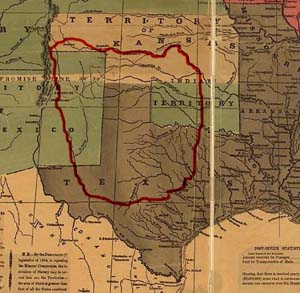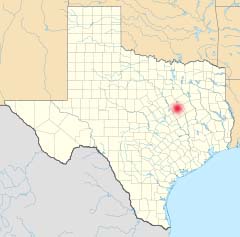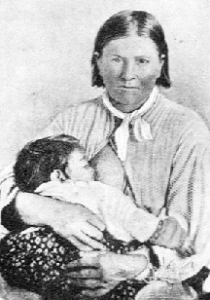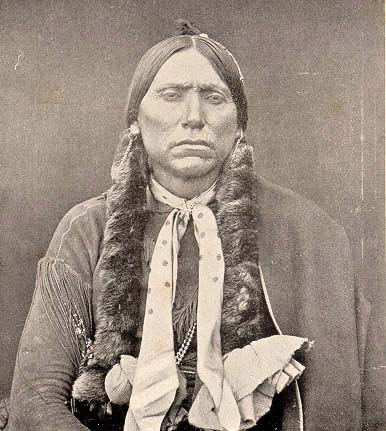Comancheria and a Brief History of the Comanche Indians
My favorite line in any movie, ever, was when Mel Gibson, in the movie, "Maverick" said, "I can't help it that the Indians were on our land before we got here!" So many people believe Indians were the "peaceful, people of the earth" that would have been at peace and would have never hurt anyone had the white man not tried to take their land. Even General George Armstrong Custer, in his time, talks about people "back east" that felt sorry for the Indians. The problem with that is, the Indians, especially the Comanche, weren't on the land that was called Comancheria for even two hundred years before the white man came. They actually drove the Apaches off through murders and depridations like they later used on the white man.
Spanish explorer, Francisco Vásquez de Coronado was the first white man to explore through the great plains of Texas. The land was so flat with no obstacles to navigate by that on several occasions, some of his men would leave the camp to hunt and never return, having gotten lost and then losing their lives due to lack of water. On some of the first maps ever drawn of the area, it was referred to as the Great American Desert. It just wasn't possible for the white man to survive in this massive region. Some way the Comanches were able to survive and not only that, they thrived. They lived off of the massive buffalo herds. When there was no water, they were known to drink the blood from a buffalo or even kill a horse and drink the fluids in the horse's stomach.
|
Comancheria, marked by the red line, was one of the last places to be populated by the white man. It was not inhabited until the Comanches were finally forced onto the reservations in the early 1880's. |
The Comanches were the baddest of the bad! No other tribes could stand before their massive power. But that power did not come along until after they discovered the horse which came after the Spaniards came to this land. There were prehistoric horses but they were nothing like the Spanish horse. At first the Spanish tried to keep the Indians from learning to ride horses but eventually the Indians learned how to ride and all Indian tribes eventually had horses. Before the horse, the Comanches like many other Indian tribes barely lived. Because of their bedouin type living, they did not stay in one place long enough to raise crops. They lived off of what the land gave them along with the buffalo.
What set the Comanches apart is that they fought as mounted horsemen! The other Indians would ride their horses into battle, then dismount and fight. This is the same way the U.S. Soldiers tried to fight the Comanches and they could not even come close, in battle, to the fierceness of the Comanche. Texas Ranger, John (Jack) Coffee Hayes was the first white man to start taking the battle to the Comanches using their warring tactics. He taught his regiment of Rangers how to shoot their guns while in the saddle. They also learned about a five-shot pistol that Samuel Colt had invented. Up until this time, rifles and pistols alike were one shot affairs. They could not be reloaded while riding. Because of this, the white man had one shot from his rifle and one shot from his pistol, then he had to fight with a sword, a tomahawk or whatever else he could hold onto. The problem with this was, the Indians had their bow and arrows and their 14 foot long lances. Even when the rifles got to where they could be reloaded while riding, the Indians could shoot five or six arrows in the time it took to load the rifle and take one shot. The Comanches' arrows were deadly accurate up to 50 and 60 yards from their target!
Samuel Colt had invented the five-shot pistol but the army wasn't interested and he went completely broke and for five years didn't produce any guns. When Jack Hayes learned of the pistol he put them to use. Each cylinder had to be loaded before the fight but each Ranger would cary four or five loaded cylinders and he could change the cylinders once he had shot all five shots. Another problem was that the caliber was .36 which was very small compared to other arms that were being used at the time. The Rangers needed more knock down power. Finally, Samuel Walker who fought with Hayes, worked with Samuel Colt and the result was the Walker Colt which was a six shot revolver that completely changed the west!
|
Location of Fort Parker on the Texas Frontier in 1836 where Cynthia Ann Parker was kidnapped by a band of Comanche Indians.Vásquez de |
The Comanches were by far the best horsemen that have ever lived. Each Comanche boy, by the age of four, was taught to ride, usually on mild pack horses. By the time he was five, he had his own horse and his grandfather or an older man in the tribe would begin to teach him to ride and to do tricks on his pony. The result of growing up riding and trick riding made the Comanches, literally the best mounted calvary the world has ever known. The Comanches would make a rope of horse hair and braid it into the horses mane. When they would attack, they would circle their enemies, riding their ponies as fast as they could run. Many times, the Comanche's enemies thought they had shot one of the Indians out of his saddle when he had just slide off the side of the pony into that rope with only his foot visible. As they rode, they would fire their rifle or their bow and arrows under the horses neck making almost impossible to shoot them. This is one of the techniques that Jack Hayes taught his regiment of Rangers. The Comanches' aim was deadly accurate while riding.
The area in which the Comanches ruled was what was commonly referred to Comancheria. As stated previously, the Apaches used to rule this part of the country and it was called Apacheria then. In the middle of the eighteenth century the Comanches defeated the Apaches and drove them into the the what is now Arizona and western New Mexico. The Comanches were able to cover an extremely large area on horseback. It wasn't anything for them to leave a camp and ride a thousand miles to raid and then return home. There were times that the warriors might even be gone from their tribes for two years to raid.
During the Civil War, the United States government largely forgot about the Great Plains. Settlers that were brave enough, or foolish enough depending on how you want to look at it, were on their own. Going into Comancheria was tantamount to suicide. From 1750 to the late 1870's the Indians killed hundreds, if not thousands and kidnapped an untold number of women and children. It was said that many Indian fighters would always keep one bullet for themselves. They knew that if they were to fall into the hands of the Indians, they would be brutally tortured before being killed and scalped. Indeed, there are many horrifying stories of what the Comanches did to white people and to members of other Indian tribes alike. After killing their enemy, they always mutilated the bodies. One of their favorite tactics was to cut off the genitals and fingers and stuff them in the person's mouth. They would pluck out the eyes, cut off noses and cut all the tendons in every joint. They believed that by doing this, their enemies would not be able to fight them in the afterlife. They thought that whatever injuries the corpse had, would be carried into the afterlife. For those who were caught alive, many were skinned alive. Many were tied to wagon wheels and roasted to death. Women were almost always gang-raped and if they were allowed to live, ended up living a life which was worse than death. The Indian squaws frequently beat the white women captives and made them basically into slaves. Small children were frequently adopted into Indian tribes and raised as Indians. Perhaps the most notable of these cases was that of Cynthia Ann Parker.
Cythia Ann Parker
|
Cynthia Ann Parker with her youngest child not long after she was recaptured by Texas Ranger, Sul Ross. She is nursing her youngest child, daughter Prairie Flower. |
While much has been written about Cythia Ann Parker, I won't attempt to cover her life in detail. Cynthia's family had built a fort
about two miles west of present Groesbeck, Texas. Due to a series of blunders in 1836, Indians attacked and killed many of the men at Fort Parker and took several people hostage.
Cynthia was nine years old and her brother John, age five, was also kidnapped. For many years nothing was heard of Cynthia and her uncle tried, on several occasions, to find her and ransom her. Many years later she was seen on two separate occasions by white men but the Indians refused to take a ransom for her. Finally, Sul Ross who later became the governor of Texas led a charge against a band of Comanche Indians, called "The Battle of Pease River" between present day cities of Crowell and Vernon, Texas. After killing all of the Indians, Ross and his men chased down an Indian on horseback. The Indian held up her young child and the men did not shoot her. It was Cynthia Ann with her young, infant daughter. Two young Indian boys were the only Indians to escape and it was later discovered that they were Cythia's sons, Quanah and Peanuts.
When Ross began to talk to his captive, he realized she had blue eyes and her hair was not as dark as the Indians'. They began to research it and realized she was the young girl who had been kidnapped 24 years earlier. During that time she had completely assimilated into the Indian culture. She had married Chief Peta Nacona, had three children by him and had completely forgotten the English language. She was sent to live with relatives but was never happy. She tried many times to run away and go back to the Indian tribes and finally, ten years later went on a self imposed hunger strike and died.
Cynthia Ann Parker's husband, Chief Peta Nacona, was chased down and killed by Sul Ross in the Battle of Pease River. Some sources say that later Parker said it was not Nacona that was killed but Quanah Parker said it was. Chief Nacona was very wealthy by Indian standards which meant he had a large horse heard. He was known for his raids and killing of white men.
Quanah Parker
|
Comanche War Chief Quanah Parker. Quanah was the chief of the Quahadi band of the Comanches. He was arguably their greatest chief. |
Cynthia Parker's oldest son, Quanah is known as one of the last great war chiefs. He led the Quahadi band of Comanches and led the army of warriors against a camp of buffalo hunters in the Red River War at the Second Battle of Adobe Walls. Quanah, who's name means "fragrance" or "stink" was a fantastically brave and brilliant warrior. Some time after the Indians were finally forced to the reservations, he became the link between the Indians and the white man. Quanah's history is very fascinating and worthy of the time to study. |





